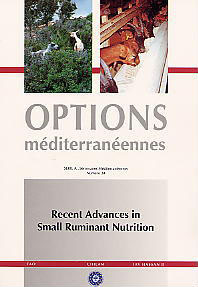| p. 11-25 | Article suivant |
Some aspects of the use of vegetation by grazing sheep and goats
Understanding the grazing animal-vegetation interactions is necessary as a basis for developing new effective grazing schemes, to improve the use of grazing lands for multipurpose uses. Due to the complexity of the grazing ecosystem, a holistic research development approach to optimise outputs and reduce unwanted side effects is required. A systems approach is suggested as the best strategy. Multifloristic vegetation composition of grasslands, particularly rangelands, coupled with variation in animal species selection necessitates the application of mixed grazing. It is intended to examine some of the main biological issues involved in the sheep-goat-vegetation grazing relationships which govern the patterns of diet acquisition and its nutritive value. Emphasis is placed on selection patterns as influenced by the presence of preferred vegetation fractions, learning patterns, anti-intake toxic factors and presence of other animals of the same or other spp. under temperate and semi-arid conditions. Parameters such as quantity of vegetation available, ease of access and distribution in the context of use of space, including water, are evaluated. A basic requirement is that grazing animals be used to maintain a sub-climax vegetation to sustain productive and protective use of grazing land resources.
- [ Afficher ]
- [ Télécharger ]
- [ Exporter la citation ]
Vous pouvez télécharger la citation au format :
- [ Imprimer ]
-
Mots-clés
CAPRIN, COMPETITION BIOLOGIQUE, OVIN, PATURAGE, REGIME ALIMENTAIRE, VEGETATIONCiter cet article
Nolan T., Nastis A.S. Some aspects of the use of vegetation by grazing sheep and goats. In : Lindberg J.E. (ed.), Gonda H.L. (ed.), Ledin I. (ed.). Recent advances in small ruminant nutrition. Zaragoza : CIHEAM, 1997. p. 11-25. (Options Méditerranéennes : Série A. Séminaires Méditerranéens; n. 34). Seminar of the FAO-CIHEAM Network of Cooperative Research on Sheep and Goats, Subnetwork on Nutrition, 24-26 Oct 1996, Rabat (Morocco). http://om.ciheam.org/om/pdf/a34/97606107.pdf



